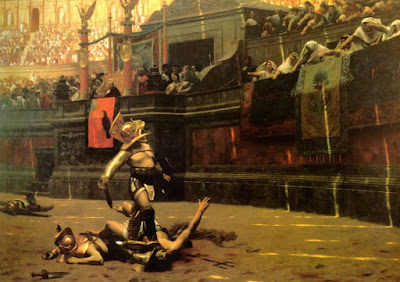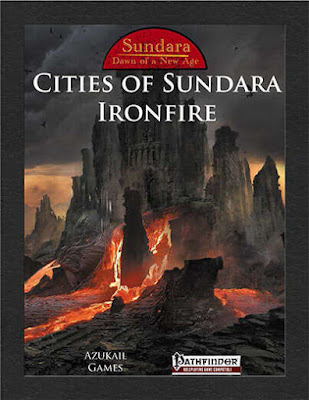And the stone rolled right back down to where it was.
You can imagine the annoyance on Sisyphus's face. The consternation. The frustration of all that effort gone to waste when the goal had supposedly been within his grasp. But he walked back down the hill, muscles trembling, and he set to again. Maybe he tried a different grip, took a different path, or tried using different shoes. In the end, it didn't matter, because the boulder rolled right back down the hill again. And again. And again.
If you're an author, chances are good that Sisyphus is probably your muse. Because no matter how you tone your craft, how hard you push, or how jacked your prose has become, chances are good that when you reach the pinnacle and finish your book that your only reward is going to be walking right down that hill to do the whole goddamn thing over again.
 |
| Just write the book. "Is there money at the top this time?" There... could be, I suppose... |
As always, for those who want to stay on top of all my latest releases don't forget to sign up for my weekly newsletter. And if you want to help me break this particular cycle so it's that much easier for me to get my own boulders to the top of the hill, consider becoming a Patreon patron to offer your support!
How Many Does It Take?
Folks who know me know that I keep pretty damn busy when it comes to content. So not only do I currently have two novels out right now (my sword and sorcery book Crier's Knife, and my noir mystery book that happens to be about cats, mice, rats, raccoons and more in NYC Marked Territory), but I've got one more getting prepped for release, and a fourth manuscript I'm going over right now. I've got a collection of short stories, The Rejects, out as well. And in addition to all of that nonsense I run two blogs, my Vocal archive is approaching 200 articles, and my name officially appears on over 100 roleplaying game supplements for sale.
And even with all of that nonsense going on, do you want to know a secret? I'll be surprised as hell if my earnings for the entire year even break 5 digits.
Stepping back to look at that fact is, in a very real way, like watching the boulder roll back down the hill one more time. Because I've been pushing it up the hill for years now, and I've gotten pretty good at that part of it. I like to think that I've cut my style, bulked my prose, and that I've got lean, tasty plots where they need to be rippling and muscular. There are even some people who cheer me on from the sidelines, waiting to see just how I get the boulder back up the hill this time.
But there is a part of my brain that just wants to pull a Maximus, hurl my sword out into the ether and bellow, "Are you not entertained?!"
 |
| Seriously, just tell me what you want, and I'll make it happen! |
The cold, hard truth that I've stated several times on this blog is that there is no knowing what will be a commercial success when you're a writer. Your first book could skyrocket to the top of the charts and make you a household name in the snap of the zeitgeist's fingers. You could write five, or ten, or twenty, and remain utterly unknown except to a small handful of people who see you at cons. Your book might sit for years in obscurity, only to be raised up by the next generation of critics who adore your work, resurrecting a project you'd all but forgotten about.
It's all a roll of the dice. Talent helps, dedication is good, and attention to detail with marketing, collaboration, interviews, getting reviews... all of that helps stack the odds in your favor. But the bones of the issue is that what makes you money and what doesn't in the world of publishing is nothing more than blind, unpredictable chance.
And it's one thing to know that, academically. But it is very cold comfort to remind yourself of this fact as you walk back down the hill, your fingertips throbbing and your mental muscles aching, whispering that it's the next one, for sure. The next one has to be the one!
You're Not Alone in This
My purpose in sharing all this with people this week is because I've been trying to talk to other creators about this feeling for months now, and every, single person I spoke to intrinsically knew what I was talking about. Not only that, but most of them are dealing with it in some capacity or another.
So if you are having trouble rolling that rock back up your hill, if you catch yourself wanting to break down and ask what's the point, I see you. And I don't have a solution, but I want you to know that you can get that sonofabitch up the hill. Because you won't know if this is the one until you haul it up there or not.
 |
| Can't win if you don't play the game. |
For folks who see their friends struggling with these boulders, and who want to help, I've provided a handy list in 10 Concrete Ways You Can Help The Authors You Like. A shorter version, though, is to provide emotional support when they need it, financial support if you can by becoming a patron or buying their books, and to boost their signals so they can find more people who want to help.
Because, honestly, the struggle isn't the rock. Rolling the rock up the hill is a breeze once you've done it a few times. But that rock is a lot lighter when you aren't worried about paying your rent, buying food, covering your taxes at the end of the year, and the thousand-and-one other little worries that drag you down and make the task so much harder.
You want to see your author soar? Help take those ankle weights off, and watch those rocks really roll!
Like, Follow, and Stay Tuned!
That's all for this week's Business of Writing! If you'd like to see more of my work, take a look at my Vocal archive, or at My Amazon Author Page where you can find books like my noir thriller Marked Territory, my sword and sorcery novel Crier's Knife as well as my recent collection The Rejects!
If you'd like to help support my work, then consider Buying Me A Ko-Fi, or heading over to The Literary Mercenary's Patreon page! Lastly, to keep up with my latest, follow me on Facebook, Tumblr, Twitter, and now on Pinterest as well!






